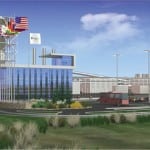The Department of Energy (DOE) on Thursday announced it would award $7 million to eight projects to advance the development of transformational oxy-combustion technologies capable of high-efficiency, low-cost carbon dioxide capture from coal-fired power plants. Leveraged with recipient cost-sharing to support about $9.4 million in total projects, the awards are expected to support the development and deployment of “carbon capture, utilization, and storage (CCUS)” by focusing on further improving the efficiency and reducing the costs associated with carbon capture.
CCUS—a term coined in recent years that has increasingly been adopted internationally as it pertains to carbon capture and storage (CCS) policy—essentially includes extraction of hard-to-access oil and natural gas resources using carbon dioxide from CCS processes. According to the DOE, by utilizing the captured carbon emissions to recover oil and natural gas resources, CCUS will provide “an additional strong business and market case for companies or organizations looking to pursue the environmental benefits of CCS.”
“These projects will build on the important progress made by this Administration in promoting innovative technologies that help make coal-fired energy cleaner and more cost-competitive. America’s leadership in developing new Carbon, Capture, Utilization and Storage technologies is helping to ensure the United States continues to lead the world in this growing global market,” said Energy Secretary Steven Chu in a statement on July 26.
The DOE’s awards are part of a two-phase effort by the National Energy Technology Laboratory (NETL) to evaluate and develop advanced oxy-combustion projects that could yield cost-competitive options for CCUS. Each project—lasting one year—will aim to achieve at least 90% carbon dioxide removal while delivering carbon dioxide at a capture cost of less than $25 per ton. The Phase 1 projects will focus on an engineering and economic analysis of the technologies while identifying the Phase 2 research and development needs to bring the technology closer to commercialization. The selection of Phase 2 projects will occur next year based upon Phase 1 results.
As the DOE describes it, the oxy-combustion process replaces air used for combustion with a mixture of oxygen and recycled plant emissions, or “flue gas,” and/or water for temperature control. The remainder of the flue gas that is not recirculated is rich in carbon dioxide and water vapor—and is “easily separated” —producing a stream of carbon dioxide ready for utilization or sequestration, the federal agency said.
The projects include:
- Alstom Power (Windsor, Conn.) — Alstom Power, through prior U.S. DOE investments, has been developing a limestone-based chemical looping combustion technology. The selected project will continue this work by enabling the full analysis of the process through an engineering system and economic study along with the development of a screening tool for process improvements. Additional analyses include the evaluation of pressurizing the limestone chemical looping combustion process. (DOE investment: $1,000,000; recipient cost-share: $250,000).
- Babcock & Wilcox Power Generation Group (Barberton, Ohio) — The project will focus on furthering the development of Ohio State University’s coal direct chemical looping process (CDCL). The CDCL process consists of a unique moving bed reactor where pulverized coal is fully converted using iron-based oxygen carriers. This reactor design and reaction pathway of CDCL process allows for retrofit, repowering, or new installations with significant reduction in the cost of oxygen production. (DOE investment: $988,000; recipient cost-share: $828,000)
- Gas Technology Institute (Des Plaines, Ill.) — This project will evaluate the potential of a novel pressurized oxy-combustion process based upon a molten bed combustor. The molten bed combustor offers higher efficiency than other known oxy-combustion processes by greatly reducing flue gas recirculation while operating at elevated pressure. The boiler concept should allow for a more compact combustor with reduced gas-phase heat exchanger surface area. (DOE investment: $800,000; recipient cost-share: $200,000)
- Pratt & Whitney Rocketdyne (Canoga Park, Calif.) — This project will evaluate a novel process for pressurized oxy-combustion in a fluidized bed reactor. The pressurized combustion in oxygen and the recycle of carbon dioxide gas eliminates the presence of nitrogen and other constituents of air, minimizing the generation of pollutants and enabling a more economical capture of CO2 gas. (DOE investment: $1,000,000; recipient cost-share: $226,000)
- Southwest Research Institute (San Antonio, Texas) — The applicant aims to investigate a novel supercritical CO2 power cycle utilizing pressurized oxy-combustion in conjunction with cryogenic compression. This power cycle leverages developments in pressurized oxy-combustion technology, a cryogenic CO2 compression system and recent developments in supercritical power cycles to achieve high net cycle efficiencies while producing a captive CO2 stream at pipeline pressures without requiring additional compression of the CO2. (DOE investment: $700,000; recipient cost-share: $175,000)
- Unity Power Alliance (Worcester, Mass.) — This project aims to evaluate the flameless combustion technology developed by ITEA under pressurized oxy-combustion conditions. Massachusetts Institute of Technology (MIT) will work with the technology developer to establish a modeling basis for the flameless reactor conditions in order to conduct a techno-economic assessment of a range of flameless pressurized oxy-combustion cycles and conditions. Laboratory data will be collected to assess the performance of the system. (DOE investment: $1,000,000; recipient cost-share: $391,000)
- University of Kentucky Research Foundation (Lexington, Ky.) — The project will investigate a heat-integrated, coal-based combined cycle for power generation using a pressurized chemical looping combustor (PCLC). The PCLC system aims to produce high-temperature flue gas for electricity generation through a gas-turbine and a heat recovery unit combined with a conventional steam cycle. The cost effectiveness and efficiency of the process using iron-based oxygen carriers will be examined. (DOE investment: $599,000; recipient cost-share: $156,000)
- Washington University (St. Louis, Mo.) — The project will evaluate the technical feasibility and improved economics of a unique pressurized system which incorporates a fuel-staged combustion approach. By staging the combustion, the temperature and heat transfer can be controlled. The potential benefits of the process are higher efficiency, reduced gas volumes, reduced oxygen demands, reduced capital costs, increased CO2 purity after combustion and reduced auxiliary power demands. (DOE investment: $854,000; recipient cost-share: $209,000)
Source: DOE
—Edited by Sonal Patel, Senior Writer (@POWERmagazine)










